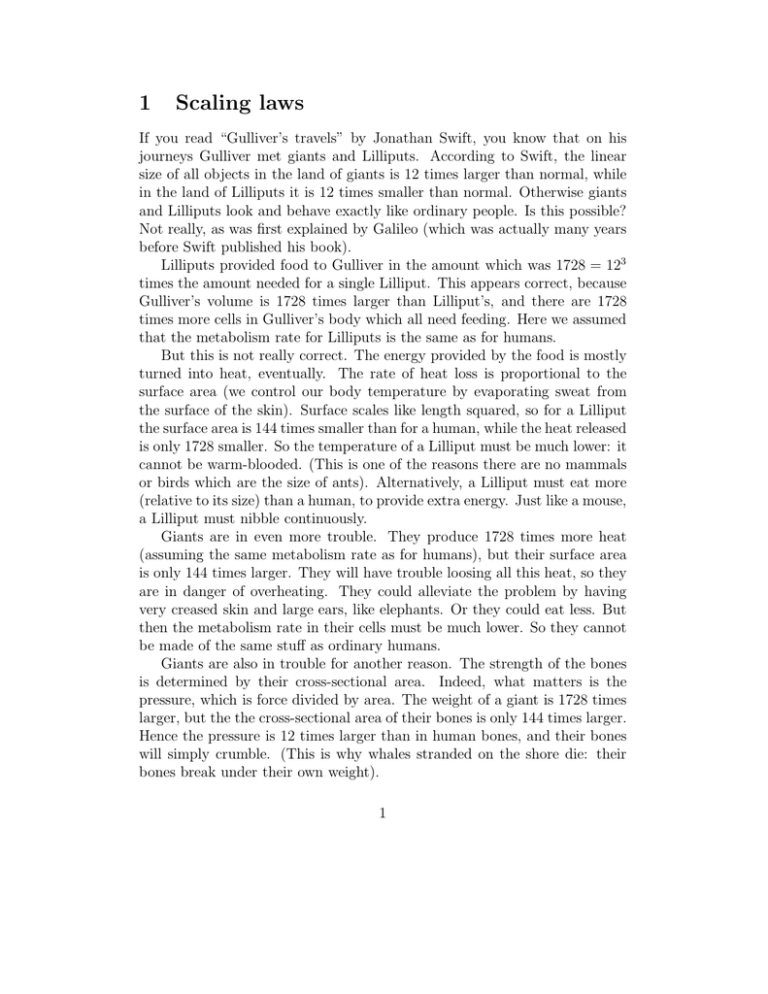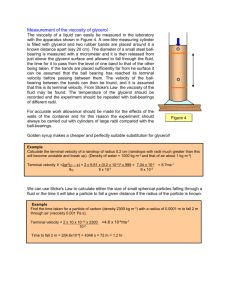1 Scaling laws - Caltech Particle Theory
advertisement

1 Scaling laws If you read “Gulliver’s travels” by Jonathan Swift, you know that on his journeys Gulliver met giants and Lilliputs. According to Swift, the linear size of all objects in the land of giants is 12 times larger than normal, while in the land of Lilliputs it is 12 times smaller than normal. Otherwise giants and Lilliputs look and behave exactly like ordinary people. Is this possible? Not really, as was first explained by Galileo (which was actually many years before Swift published his book). Lilliputs provided food to Gulliver in the amount which was 1728 = 123 times the amount needed for a single Lilliput. This appears correct, because Gulliver’s volume is 1728 times larger than Lilliput’s, and there are 1728 times more cells in Gulliver’s body which all need feeding. Here we assumed that the metabolism rate for Lilliputs is the same as for humans. But this is not really correct. The energy provided by the food is mostly turned into heat, eventually. The rate of heat loss is proportional to the surface area (we control our body temperature by evaporating sweat from the surface of the skin). Surface scales like length squared, so for a Lilliput the surface area is 144 times smaller than for a human, while the heat released is only 1728 smaller. So the temperature of a Lilliput must be much lower: it cannot be warm-blooded. (This is one of the reasons there are no mammals or birds which are the size of ants). Alternatively, a Lilliput must eat more (relative to its size) than a human, to provide extra energy. Just like a mouse, a Lilliput must nibble continuously. Giants are in even more trouble. They produce 1728 times more heat (assuming the same metabolism rate as for humans), but their surface area is only 144 times larger. They will have trouble loosing all this heat, so they are in danger of overheating. They could alleviate the problem by having very creased skin and large ears, like elephants. Or they could eat less. But then the metabolism rate in their cells must be much lower. So they cannot be made of the same stuff as ordinary humans. Giants are also in trouble for another reason. The strength of the bones is determined by their cross-sectional area. Indeed, what matters is the pressure, which is force divided by area. The weight of a giant is 1728 times larger, but the the cross-sectional area of their bones is only 144 times larger. Hence the pressure is 12 times larger than in human bones, and their bones will simply crumble. (This is why whales stranded on the shore die: their bones break under their own weight). 1 The cross-sectional area of the giants’ muscles is also 144 times larger than that of human muscles, so they have 144 times more muscle fibers and are 144 times stronger than humans. But their weight is 1728 larger! So they will have trouble moving their own body around (for example, lifting arms and walking may be a problem: imagine each of your arms and legs weighing 12 times more!) For the same reason Lilliputs should be 12 times stronger than humans, relative to their weight. They should be able to lift objects much heavier than their own weight, like ants, and jump much higher than their own height, like grasshoppers. Surface tension effects are also much more important at small scales: the force due to surface tension is proportional to the length, while the gravity force and inertia scale like mass, i.e. L3 . Therefore surface tension is 144 times more important in the world of Lilliputs than for us. At human scales, the effects of surface tension are negligible. Indeed, the force due to gravity is of order ρgL3 , the force due to surface tension is of order σL, where σ is the surface tension, and their ratio is of order ρgL2 /σ. For water σ ≃ 0.1N/m, so at the human scale L = 1m the ratio is about 105 . For Lilliputs the ratio is 103 . For creatures the size of an ant the ratio is between 10 and 1. (This is the reason some insects may use surface tension to run on the surface of water). 2 Scaling laws in hydrodynamics Let us estimate the relative importance of inertial (or kinetic) effects and viscosity. The liquid pressure due to kinetic energy is ρv 2 . 2 The pressure due to viscosity is of order ηv/L, where L is the linear size of the object. The ratio is R= ρvL . η 2 This is known as the Reynolds number. If it is large, the effects of viscosity are small; if it is small, the effects of viscosity are large. Let us compute some numerical values. The viscosity of air is 1.8·10−5P a· sec, the viscosity of water is 0.001P a · sec. Hence at human scale L = 1m and velocity about 1m/sec the Reynolds number in the air is about 105 . For a swimmer the Reynolds number is about 106 (the viscosity of water is larger than the viscosity of air, but its density is also much larger). For a microscopic organism in water with L = 10−5 m which moves with a velocity 10−4 m/sec the Reynolds number is about 0.001, i.e. the effects of viscosity are very important. If we have a model of an airplane which is 1000 times smaller than the real plane, and we want test it, to ensure that the Reynolds number is the same as for the real plane we must either increase the velocity by the same factor, or decrease the viscosity of the medium, or increase its density. Reynolds number is important because at large Reynolds numbers (typically, a few thousand) the flow becomes turbulent (i.e. chaotic). Turbulence leads to a qualitatively different flow. Here is an example. At low Reynolds numbers, when the flow is laminar (the opposite of turbulent) and viscosity effects dominate, we can estimate the force of resistance on a moving object as follows. The pressure due to viscosity is about p ∼ ηv/L. Hence the resistance force is about F ∼ pL2 ∼ ηvL. Note three things: the force is independent of the density of the medium, is proportional to the velocity, and is proportional to the linear size of the object. At high Reynolds numbers we can neglect viscosity altogether, and the resistance force is about pL2 ∼ ρv 2 L2 . It is proportional to the square of velocity and the square of the linear size. This is a qualitative change compared to the low-Reynolds-number case. Here is an application of these considerations. Suppose we want to pump liquid through a pipe. How much pressure do we need for that? The Reynolds number here is ρvr/η, where r is the radius of the pipe. For low Reynolds 3 numbers the pressure due to viscosity is about ηv/r. The corresponding force is p times 2πrL, where L is the length. Hence the external force must be about ηvL. The external pressure difference is obtained by dividing this by the cross-sectional area of the pipe; the result is of order ηvL/r 2 . It is more useful to express v in terms of the flow rate Q, i.e. the volume of liquid which enters the pipe per unit time. We have Q = 2πr 2 v, hence the pressure difference must be about p ∼ ηQL/r 4 . Thus if you decrease the radius of the pipe by a factor 2, the pressure gradient needed to pump the same amount of liquid per unit time will grow by a factor 16. This is important for the physiology of blood circulation! For large Reynolds numbers, on the other hand, the resistance pressure is of order ρv 2 , hence the resistance force is of order ρv 2 Lr, hence the external pressure difference driving the flow must be about ρv 2 L/r. In terms of the flow rate Q, this reads ρQ2 L/r 5 . Thus turbulence makes things even worse, in a sense, because the pressure grows like the square of the flow rate Q, and in addition is proportional to r −5 . Another application is the so-called terminal velocity. If you drop an object, at first it will accelerate downward, but as its velocity increases, the force of resistance also increases, and eventually the velocity approaches a constant value. This constant value is known as the terminal velocity. The terminal Reynolds number may be either in the laminar or the turbulent regime: that depends on the mass of the falling object. Let us see how it works. Suppose first the terminal velocity is in the laminar regime. Then the force balance requires ηvL ∼ mg, or v∼ mg ρo gL2 ∼ . ηL η 4 Here ρo is the density of the object. The corresponding terminal Reynolds number is mgρ R ∼ 2 ∼ ρo ρgL3 η 2 . η This number should not be too large (say, less than 1000), otherwise the terminal regime is turbulent. For example, for air η ∼ 1.8 · 10−5 P a · sec, so for the Reynolds number to be less than 1000, the mass of the object should be less than about 3 · 10−11 kg = 3 · 10−8 g. A typical dust particle has mass of order 10−5 g, so even a dust particle does not fall in a laminar regime. An typical amoeba has a mass of order 10−9g, so it would fall in a laminar regime. The viscosity of water is much larger, but its density is also larger. Thus in water anything heavier than a dust particle will reach a turbulent regime. In the turbulent regime, the balance of forces requires ρv 2 L2 ∼ mg. Hence v∼L −1 s mg ρ Note than in both cases (laminar and turbulent) the terminal velocity is inversely proportional to the size of the object. (The slope is different though). This makes sense, of course: the smaller the size of an object, the smaller the effects of “air resistance”, and the greater the terminal velocity. Equivalently, we can express m through the density of the object ρo and its size, m ∼ ρo L3 , then the terminal velocity is proportional to L3/2 /L = L1/2 . Thus if A and B are made of the same stuff and A is twice √ larger than B, then the terminal velocity for A will be larger by a factor 2. Or, since m ∼ L3 , we have v ∼ m1/6 . For example, a typical elephant weighs about 5000kg, a typical mouse weighs about 25g, hence an elephant is about 200000 times heavier than a mouse. But if one drops an elephant and a mouse from an airplane, the terminal velocity of the elephant will be only about 8 times larger than the terminal velocity of the mouse. Question for the reader: would the elephant go supersonic? 5






